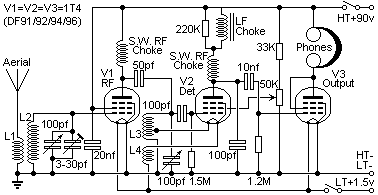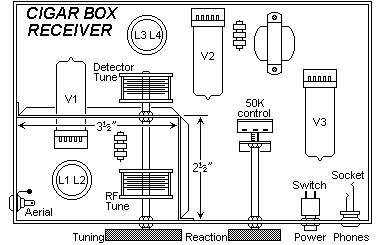

1 Figure
A receiver counterpart to the small one-watt transmitter described in
the March issue. By T. W. Dresser.
In a recent issue of Practical Wireless the writer described the
"Cigar Box Transmitter," an extremely small 1 watt transmitter
suitable for the amateur without mains electrical supplies or who is
so restricted for space that anything in the nature of a normal sized
shack and transmitter is entirely out of the question. In the present
article it is proposed to describe the receiver counterpart to that
transmitter, an equally small unit which, despite its small size and
simple circuit arrangement, will nevertheless put up quite a good
show.
To begin with, those who think only in terms of double conversion,
crystal filters, phasing controls and the other more elaborate gagets
of the high-priced commercial receivers, will not be interested in
this receiver. None of those adornments can be built into a TRF
amplifier, leaky-grid detector, with reaction and audio amplifier.
All the valves are of the same type, 1T4's, just as are those in the
transmitter. The excellent performance arises principally from good
layout, adequate screening and the very smooth regeneration provided
by potentiometer control on the screen grid of the detector. It has
been called a cigar box receiver, and can easily be built into such a
box, as was the original, but there is no reason why it should not be
assembled in a metal case or on a small metal chassis, and, in some
cases, this may be an advantage in that it helps to keep down
hand-capacity effects. These were not noticeable in the prototype, as
the cigar box was completely lined with aluminium foil, which made a
most effective scree.
The form of construction used at the RF end may be rather unusual but
it has many advantages, noticeably in keeping grid and anode leads
down to a minimum length and in isolating the RF stage from the
detector as far as unwanted interaction was concerned. Nor is it
difficult to build as the screen can be removed from the box, the RF
valveholder and the detector grid coil holder fitted and wired to
some extent before it is permanently fastened into position. This
greatly facilitates construction.
As originally built, the receiver covered the five main amateur bands
3.5 7, 14, 20 and 30 Mc/s, using a ganged 15pf funing condenser. With
some small changes it can be made to cover 3.5 - 30 Mc/s continuously
and the coil data and all necessary information is given for both
coverages.
The theoretical diagram is given in Fig. 1 and
it will be noted that the reaction is controlled by varying the
screen-grid voltage, a method which has a lot in its favour in that
it does not affect the tuning to any noticeable degree. The detector
anode load is a high-inductance LF choke of some hundreds of Henries
and that used by the writer was a pre-war component. It is
questionable whether such a choke can be obtained today, but the
primary winding of an ordinary inter-valve transformer will serve
just as well (I used a 28v PCB relay - Harry). In that case, the
secondary can be left disconnected or placed in series with the
primary, but care must be taken to see that it is truly in series and
not connected in such a way that it reduces the inductance of the
primary, which can happen. As with its companion transmitter, all
components should be as small as possible consistent with good
quality.

Figure 2
Figure 2 shows the lay-out of the receiver. The
cigar box is lined with thin completely flat and unwrinkled aluminium
foil, pressed well down at all corners and fastened round the edge of
the box with drawing pins or strips of aluminium screwed down. The
screens are then cut and bent from sheet aluminium as shown in Fig. 2
(CIGAR-TM.GIF - Harry), and the RF valveholder and detector grid
goil-holder mounted as shown. The screen can then be screwed inside
the box with very small brass wood screws of no more than 3/16in. or
1/4in. in length. The remainder of the construction and the wiring
are quite straightforward and if the diagrams are followed carefully,
there is little likelihood of error. As with any other short-wave
receiver all wiring should be as short as possible, and a common
earthing point should be used for each stage. Coil formers should be
of good quality material, such as polystyrene, and the tuning gang
(or coupled condensers) should preferably have ceramic insulation.
The only difference between the amateur band version, and that for
3.5 - 30 Mc/s continuous coverage are in the size of the coil formers
and the sockets for them, and in the capacity of the tuning
condensers. In the first mentioned the coil formers are Maxi-Q dust
cored 5-pin types, with holders to suit, and the tuning condenser is
a 2-gang 15pf variable or two separate 15pf coupled together. In the
continuous coverage version the tuning condenser is a two-gang 100 pf
variable, and the coil formers are standard 1-1/4in. 5-pintypes with
sockets to match. The change in the mechanical layout is so small
that it needs no detailed description.
As the interior of the cigar box is completely covered with aluminium
fail, it is advisable to keep a close eye on connections and wiring
generally in order that they may not earth to the foil. Where there
is a danger of this a small piece of cardboard or fibre under
valveholders and at strategic points will eliminate the danger. As
with all TRF receivers, a good aerial is half the battle. If the
receiver is to be used with the cigar box transmitter the same aerial
will serve both; a simple form of switching will change over the
batteries and the aerial from transmitter to receiver simultaneously.
If the receiver is to be used alone, an aerial as high and as long as
possible should be erected.
In conclusion, the quiet background and signal getting qualities of
this little set will prove a pleasant surprise to those accustomed to
elaborate AC types, and, at the same time, its cheapness is such that
even the beginner need not remain without a short-wave receiver if he
has the pound or two necessary to build it.
Coil data for 3.5 to 30 Mc/s continuous coverage
Band L1 L2 L3 Tap L3 L4
==== ========== =========== =========== ==== ============
1 6 turns 28 25 turns 28 25 turns 28 4 4 turns 28
swg enamel swg enamel swg enamel swg enamel
==== ========== =========== =========== ==== ============
2 5 turns 28 14 turns 28 14 turns 28 3 3 turns 28
swg enamel swg enamel swg enamel swg enamel
==== ========== =========== =========== ==== ============
3 3 turns 28 6 turns 28 6 turns 28 2.5 2.5 turns 28
swg enamel swg enamel swg enamel swg enamel
==== ========== =========== =========== ==== ============
Coil data for amateur bands
Band L1 L2 L3 Tap L3 L4
==== ========== =========== =========== ==== ============
3.5- 7 turns 28 60 turns 60 turns 10 10 turns
4.0 closewound closewound
==== ========== =========== =========== ==== ============
6.9- 5 turns 30 turns 30 turns 5 5 turns
7.4 closewound closewound
==== ========== =========== =========== ==== ============
13.9 3 turns 20 turns 20 turns 3.5 3.5 turns
14.4 spaced 1/2" spaced 1/2"
==== ========== =========== =========== ==== ============
20.5 3 turns 13 turns 13 turns 3 3 turns
22.0 spaced 1/2" spaced 1/2"
==== ========== =========== =========== ==== ============
27.0 2 turns 10 turns 10 turns 3 3 turns
30.0 spaced 1/2" spaced 1/2"
==== ========== =========== =========== ==== ============
Have fun, de HARRY, SM0VPO Upplands Vasby, Sweden
Frank, G3YCC